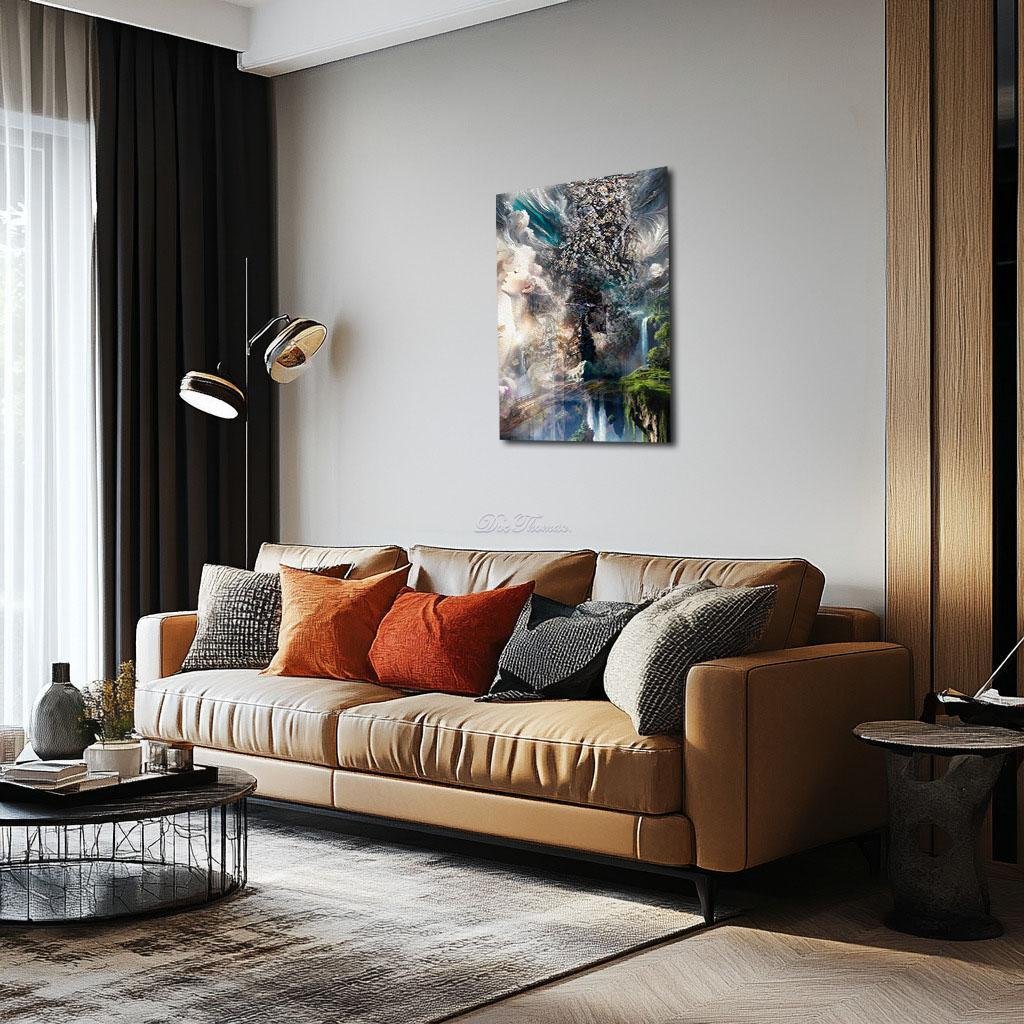Veins of Porcelain: Beneath the Waters Where Silence Grows
Veins of Porcelain: Beneath the Waters Where Silence Grows reinterprets Pollock’s Sea Change as a vertical symphony of elemental rebirth. Pollock’s tangled lines become the bark and bloom of a cosmic tree, stretching through clouds and cascading waterfalls. A woman’s face emerges from mist and sky, serene and surrendering, as cliffs rise and waters fall in a world between gravity and grace. Pollock’s color eruptions, once chaotic, now read as petals and pulses. This is a painting of quiet metamorphosis, where turbulence becomes growth, and silence is not absence—but becoming.
Please see Below for Details…
Hotline Order:
Mon - Fri: 07AM - 06PM
404-872-4663
Veins of Porcelain: Beneath the Waters Where Silence Grows reimagines Jackson Pollock’s Sea Change as a mythic cascade of metamorphosis, where elemental force and ethereal longing braid into a vertical cathedral of rebirth. In this vision, Pollock’s explosive abstraction is not mere turbulence, but the trunk of a great cosmic tree—its branches swelling with floral chaos, its roots embedded in celestial clouds and ancient earth. Here, nature is not the subject, but the witness. The world folds gently into itself, and what Pollock once cast in fury is now rendered as reverence.
The composition is built as a vertical pilgrimage. At its base, lush cliffs rise above pools of iridescent blue, waterfalls threading through floating islands that seem to hover just beyond comprehension. From these watery cradles, mist rises—transforming into cloud, then into face. A woman’s profile, soft and radiant, emerges from the vapors like a whispered memory of the sea herself. Her expression is not one of joy or sorrow, but of release. Her face, bathed in the soft sheen of reflective light, carries the serenity of someone who has returned to the place from which all things are born.
At the composition’s center surges the full force of Pollock’s original Sea Change —a burst of gestural lines and pulsing pigments, now blooming upward like a living tree. His chaotic layering, once described as spontaneous combustion, now reveals itself as growth, branching upward with a rhythm that recalls both storm and symphony. The painting, originally horizontal and writhing, is reoriented here as a trunk—a sacred axis where all elements converge. His whites become blossoms. His blacks, deep bark. His blues pulse like veins in wood and memory alike.
Color is both elemental and emotional. The greens of the floating cliffs shimmer with life, punctuated by the soft emerald of moss and the deep jade of shadowed foliage. Waterfalls glisten in translucent silvers and cool turquoises. Above them, the sky ripples in pastel lavender, milky blue, and marbled ivory—creating a dreamscape of weightless atmosphere. Pollock’s own colors still roar: ochres, fiery reds, wet asphalt blacks, and eggshell whites. Yet in this new rendering, they don’t scream—they sing. His strokes now read as growth rings of experience, spiraling outward into eternity.
As an artist, my thought while constructing this reinterpretation was shaped by the idea that turbulence, when viewed through the lens of time, becomes ecology. What once feels like disorder becomes the conditions for blooming. Pollock’s Sea Change was an eruption of instinct and possibility. Here, I wanted that eruption to become rooted, to become a memory the world itself remembers in bloom and erosion.
The presence of the woman was a deliberate act of anchoring. She is not symbolic in a classical sense, but elemental—an avatar of breath, of reflection. Her position within the clouds links her not to heaven, but to evaporation—to the transformation of water, of matter, of feeling. She is the sea’s ghost, perhaps, or its lullaby. The way she leans into the air is a gesture of both surrender and return.
The bridge in the lower left is subtle but necessary. It represents the passage—between then and now, between wound and recovery, between storm and root. It’s weathered and narrow, suggesting that this journey—the sea change—is not without its cost. But it leads not away from chaos, but into it. Because in this vision, chaos is no longer the enemy. It is the garden.
Veins of Porcelain: Beneath the Waters Where Silence Grows is not a depiction of transformation, but an immersion into its rhythm. It’s a painting that no longer divides nature from abstraction, woman from element, or collapse from growth. It’s about the slow shift from being broken apart to being grown into something wider, softer, fuller. It is not silence after storm—it is the voice the storm teaches you to hear.
Add your review
Your email address will not be published. Required fields are marked *
Please login to write review!
Looks like there are no reviews yet.








